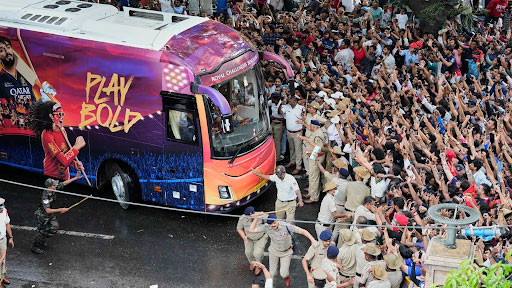Daijiworld Media Network - Bengaluru
Bengaluru, July 17: The Karnataka government’s official report has placed blame squarely on the Royal Challengers Bangalore (RCB) team, their event management partner DNA Networks Private Limited, and the Karnataka State Cricket Association (KSCA) for the tragic stampede at Bengaluru’s M Chinnaswamy Stadium, which claimed 11 lives.
Shockingly, the report also cites star cricketer Virat Kohli’s name, noting his role in inviting fans to the ill-fated victory celebrations.

Unauthorised mega celebration triggers fatal chaos
The report, submitted to the Karnataka High Court, reveals that RCB orchestrated a massive victory parade and festivities without securing mandatory permissions from city officials or the police. The unilateral announcement led to a massive, uncontrolled surge of fans rushing to the stadium, culminating in a deadly stampede.
Despite the critical nature of the event, neither the team’s management nor its governing board obtained official approvals. The Karnataka government states that although the RCB board informed the police of a “possible celebration” on June 3—the day RCB clinched the IPL title after 18 years—this was not a formal permission request, which legally must be submitted at least seven days in advance.
Public invited via social media without police consent
Ignoring police advice, RCB’s management posted a public invite early on June 4 through official social media channels, announcing free entry and inviting the public to join a parade starting at Vidhana Soudha and ending at Chinnaswamy Stadium. The posts, which went viral, featured a video clip of Virat Kohli encouraging fans to celebrate, intensifying public enthusiasm.
By afternoon, RCB declared the parade timing and route and mentioned the availability of limited free passes online—although details about pass distribution remained unclear, effectively making the event open to all.
Overwhelming crowd and insufficient safety measures
The report estimates the crowd swelled beyond 300,000 people, based on metro ridership data showing nearly one million passengers on June 4 — well above the usual 600,000 daily average. Thousands also gathered along the parade route from HAL Airport to Taj West End and from Vidhana Soudha to the stadium.
Videos circulating on social media captured uncontrolled waves of people, which increased the risk of disaster. The report faults the organizers for failing to share crucial event details with authorities, resulting in inadequate crowd control and police deployment.
No formal permission, no crowd control plan
Under Bengaluru’s 2009 Public Gathering Rules, no formal application for police permission was ever submitted. Key information—such as expected attendance, timing, organizer contacts, and security plans—was missing, preventing police from assessing the event’s scale or arranging sufficient security.
No public announcements, crowd management staff, or loudspeakers were deployed. Organizers also failed to arrange or fund the required police security, violating government directives issued in 2019.
Police struggles amid lack of cooperation
Despite these gaps, Bengaluru Police deployed over 650 personnel and established barricades and control zones to manage traffic and crowds. They coordinated media advisories urging the public to avoid central areas and use public transport.
However, the spontaneous, unprecedented turnout and absence of prior coordination overwhelmed police efforts, leading to fatal chaos.
Accountability and suspensions
Highlighting serious lapses by RCB, DNA Networks, and KSCA in following safety protocols, the government took swift action by suspending five police officers, including three senior IPS officials, for their failure to manage the event.